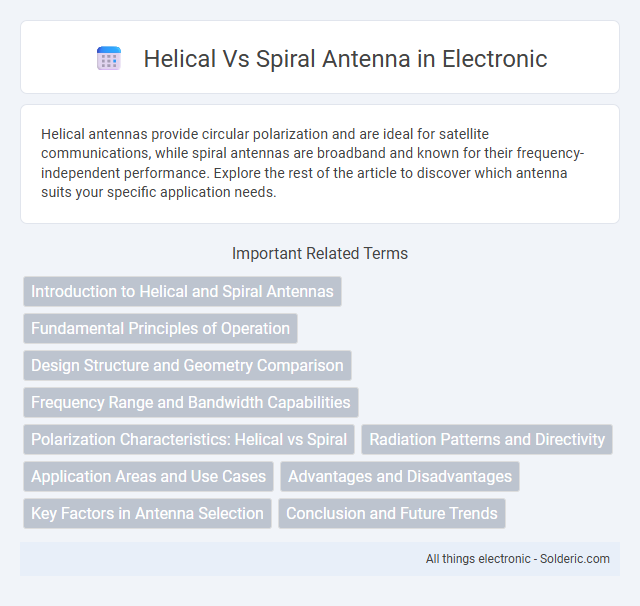Helical antennas provide circular polarization and are ideal for satellite communications, while spiral antennas are broadband and known for their frequency-independent performance. Explore the rest of the article to discover which antenna suits your specific application needs.
Comparison Table
| Feature | Helical Antenna | Spiral Antenna |
|---|---|---|
| Structure | Wire wound in a helix shape around a cylindrical form | Two or more arms spiraled in a plane, typically Archimedean spiral |
| Polarization | Typically circular polarization | Typically circular polarization |
| Radiation Pattern | Directional with main lobe along helix axis | Wideband with nearly frequency-independent, broadside radiation |
| Frequency Bandwidth | Narrow to moderate bandwidth | Ultra-wideband frequency coverage |
| Typical Applications | Satellite communications, space telemetry | Wideband communications, surveillance, electronic warfare |
| Gain | Moderate to high gain | Moderate gain |
| Size | Relatively larger due to multiple turns | Compact and planar |
Introduction to Helical and Spiral Antennas
Helical antennas consist of a conductive wire wound in a helix shape, primarily used for circular polarization and wide bandwidth applications. Spiral antennas feature multiple spiraled arms, offering ultra-wideband performance and frequency-independent radiation patterns. Your choice between the two depends on the need for compact design and specific polarization or bandwidth requirements in wireless communication systems.
Fundamental Principles of Operation
Helical antennas operate on the principle of electromagnetic wave propagation along a helical conductor, producing circularly polarized radiation primarily through axial mode when the circumference is approximately one wavelength. Spiral antennas function based on self-complementary, frequency-independent elements that create broadband, planar circular polarization by exciting traveling waves along the arms of the spiral. The key operational difference lies in helical antennas utilizing a three-dimensional helical geometry for directive gain, whereas spiral antennas use a flat, planar structure for ultra-wideband frequency response and bidirectional radiation patterns.
Design Structure and Geometry Comparison
Helical antennas feature a wire wound in a cylindrical shape with a constant pitch angle, radius, and number of turns, designed to operate in axial mode for circular polarization and directional radiation. Spiral antennas consist of multiple arms that wind outward in a flat, planar geometry, typically forming Archimedean spirals to achieve wideband frequency response and consistent impedance. The primary design difference lies in helical antennas' three-dimensional helix shape promoting gain and directivity, while spiral antennas use planar spiral geometry optimizing broadband characteristics and low-profile integration.
Frequency Range and Bandwidth Capabilities
Helical antennas typically operate effectively in the VHF to UHF frequency ranges, offering moderate bandwidth suitable for applications like satellite communication and GPS. Spiral antennas provide ultra-wideband performance, covering frequencies from VHF through microwave bands, ideal for broadband and radar systems. The bandwidth of spiral antennas can exceed several octaves, whereas helical antennas usually offer narrower bandwidth limited by their single- or multi-turn geometry.
Polarization Characteristics: Helical vs Spiral
Helical antennas exhibit circular polarization, which can be right-hand or left-hand depending on the winding direction, providing consistent signal quality for satellite and wireless communication. Spiral antennas generate broadband circular polarization with a wider frequency range, making them ideal for applications requiring frequency agility and omnidirectional reception. Understanding these polarization characteristics helps you select the antenna type that best matches your communication system's requirements.
Radiation Patterns and Directivity
Helical antennas exhibit a distinctive conical radiation pattern with high axial directivity, ideal for circularly polarized signals and longer-range communication. Spiral antennas generate broad, frequency-independent radiation patterns with nearly uniform directivity across a wide bandwidth, suitable for wideband applications and signal detection. Your choice depends on whether you prioritize focused, high-gain radiation or wideband coverage with consistent directivity.
Application Areas and Use Cases
Helical antennas are widely used in satellite communications, space probes, and radio astronomy due to their circular polarization and high directivity, making them ideal for reliable signal transmission in line-of-sight environments. Spiral antennas excel in wideband applications such as surveillance, radar systems, and electronic warfare, offering broad frequency coverage and ultra-wideband radiation patterns. Choosing the right antenna depends on your need for either focused, high-gain signals in constrained frequency bands or flexible, wideband reception across multiple frequencies.
Advantages and Disadvantages
Helical antennas offer advantages such as wide bandwidth, circular polarization, and simple construction, making them ideal for satellite and GPS applications; however, their size can be bulky and less suitable for compact devices. Spiral antennas provide ultra-wideband performance and frequency independence, suitable for direction finding and radar, but they often require complex feeding mechanisms and exhibit lower gain compared to helical antennas. Your choice depends on application needs, balancing the helical antenna's stable gain with the spiral antenna's broad frequency coverage.
Key Factors in Antenna Selection
Helical antennas provide improved circular polarization and wide bandwidth, making them ideal for satellite and space communication applications, while spiral antennas offer ultra-wide bandwidth and frequency independence suitable for broadband and direction-finding systems. Your choice depends on factors like required bandwidth, polarization type, radiation pattern, and physical size constraints. Evaluating these key parameters ensures optimal performance tailored to your communication needs.
Conclusion and Future Trends
Helical antennas offer robust circular polarization and wide bandwidth, making them ideal for satellite communication and space applications, while spiral antennas provide ultra-wideband performance and frequency-independent characteristics suitable for radar and broadband systems. Future trends point towards integrating metamaterials and AI-driven design optimization to enhance gain, miniaturization, and multi-band capabilities in both antenna types. Research is increasingly focused on flexible, wearable, and reconfigurable antennas to meet evolving wireless communication demands.
helical vs spiral antenna Infographic

 solderic.com
solderic.com